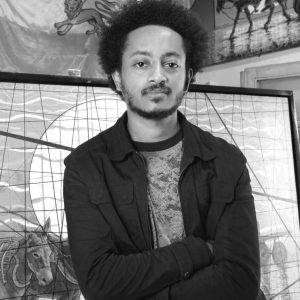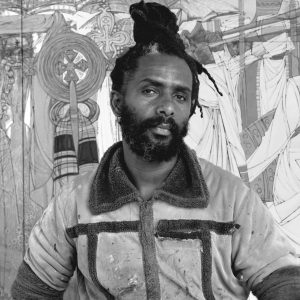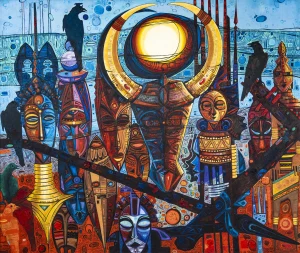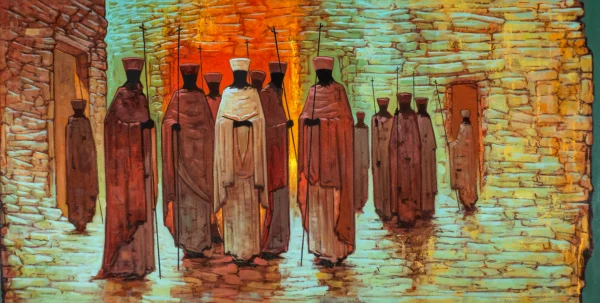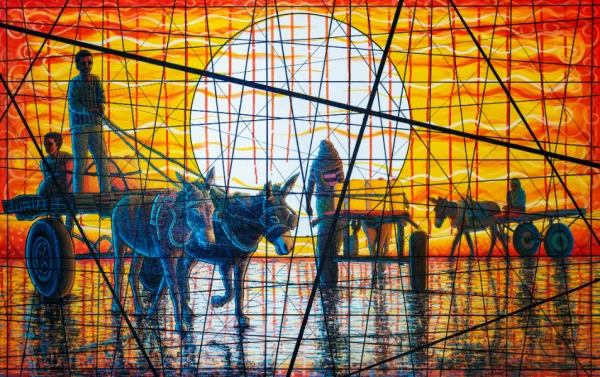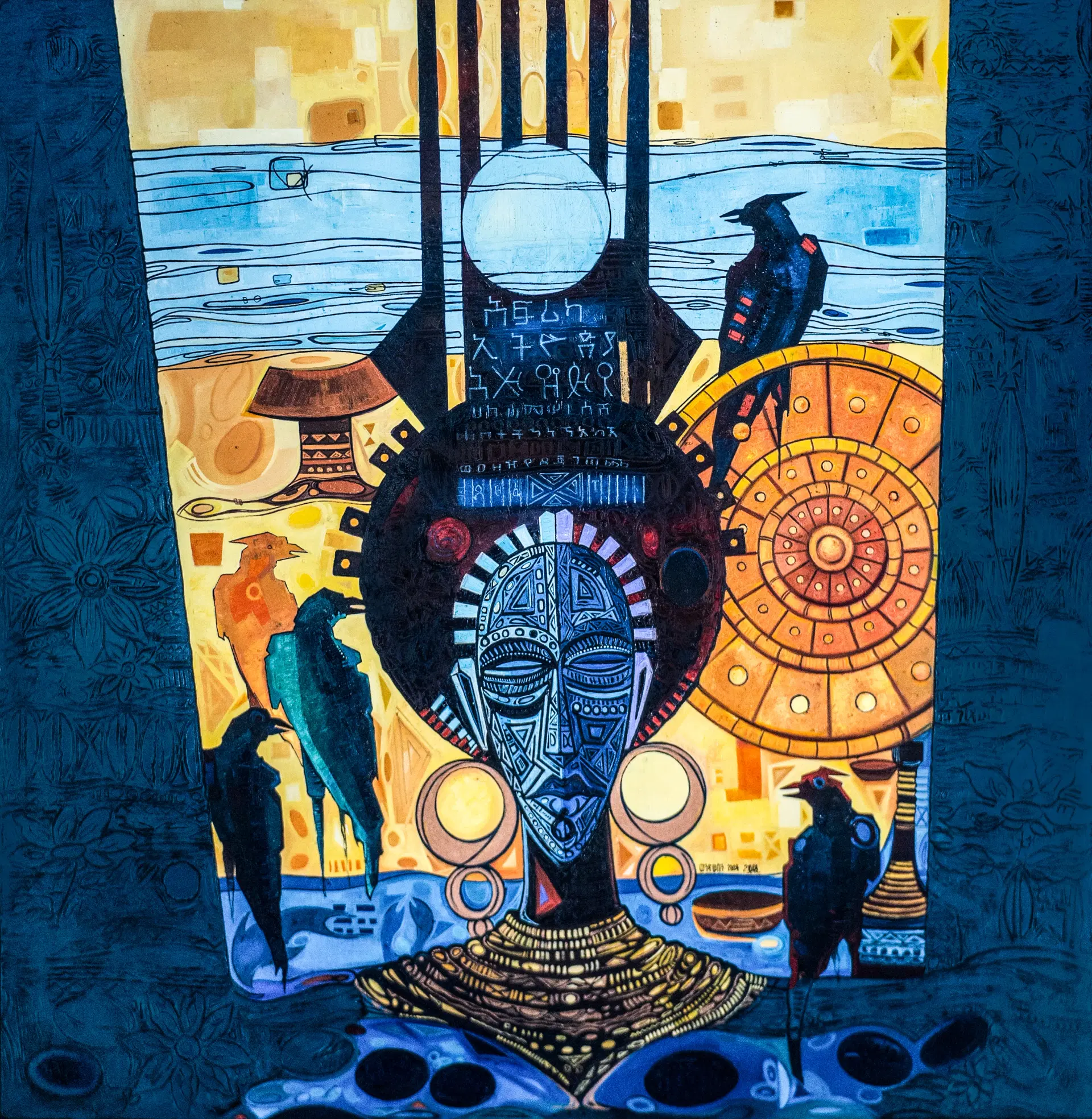
Light of the Ancestors: Why the World Can No Longer Ignore Ethiopian Art
There are moments in the life of a nation when its stories must be told—not whispered in the margins, but shouted through color, form, and fire. With his latest work, Sun Above the Ancestors, Ethiopian artist Wendwesen Kebede Abera does precisely that. He doesn’t just paint a scene—he delivers a reckoning. A reckoning with history. With memory. With beauty. And with power.In a world where the global art scene is saturated with Western narratives, minimalism, and commercial trends, Sun Above the Ancestors cuts through the noise like a sunrise breaking over the Ethiopian highlands. It is urgent. It is luminous. It is unapologetically African—and undeniably Ethiopian.Now released in a rare edition of 100 signed prints through Adulis Ethiopian Art, this masterpiece offers not just ownership of a powerful visual work—but stewardship of a story that demands to be seen, remembered, and shared.
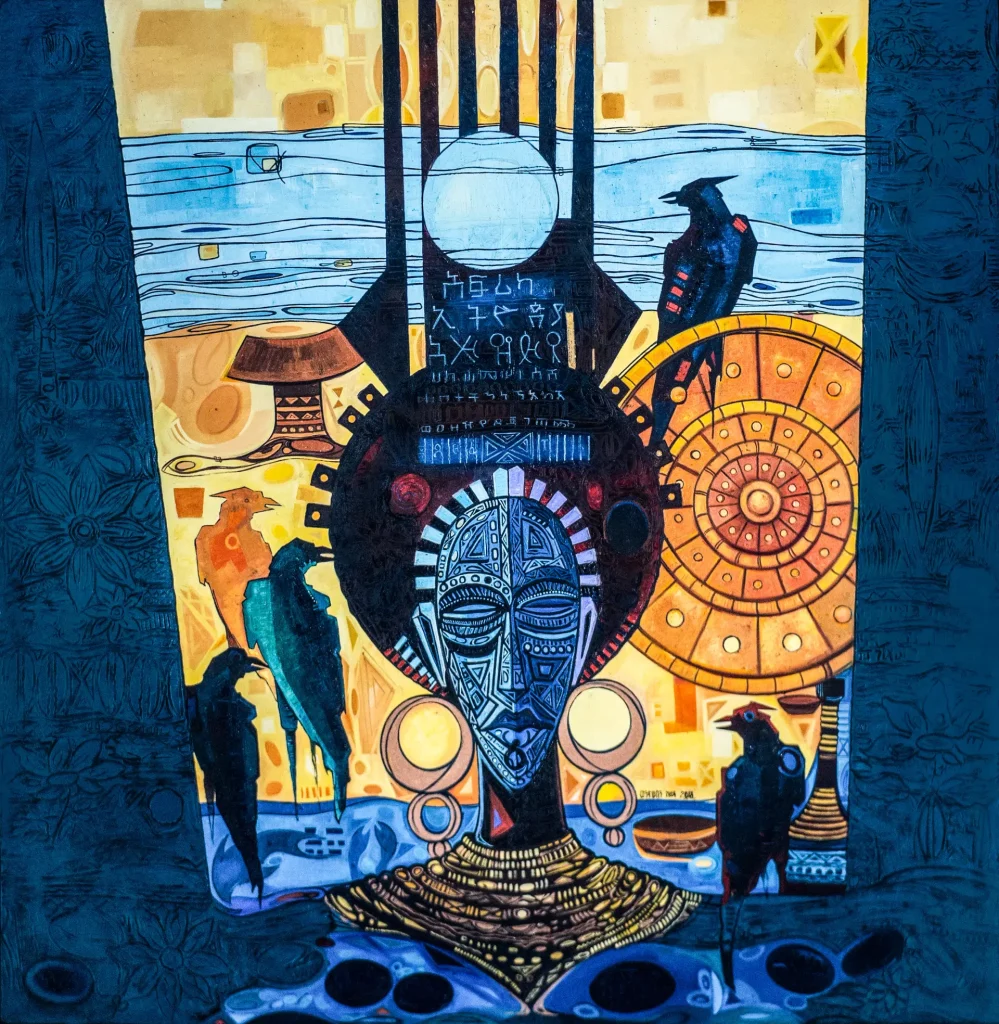
Ethiopia: The Unseen Pillar of Global Art History
For centuries, Ethiopia has stood as a beacon of independence, identity, and resilience. It is the only African nation never to be colonized. Its script, Ge’ez, predates the Roman alphabet. Its Orthodox Church is one of the oldest in the world. Yet somehow, in the global art narrative, Ethiopia has remained in the periphery.
That ends now.
Wendwesen’s work emerges not as novelty—but as necessity. His brush revives ancient traditions with radical intimacy, reminding the world that the cradle of humanity has always been a cradle of creativity, too.
Ethiopia is not just historically significant—it is artistically sovereign. From the ancient rock churches of Lalibela to illuminated manuscripts and richly painted Orthodox icons, Ethiopia has for centuries expressed itself through complex visual languages. It is this deep legacy that Wendwesen draws from—and extends.
Inside the Work: A Gathering of Spirit and Lineage
Sun Above the Ancestors is a ceremonial painting. A vision of the past meeting the present through color, sacred geometry, and symbology rooted in Ethiopian tradition.
The Radiant Sun: Hovering like a divine eye, the central sun serves not just as a celestial body, but as a metaphor for ancestral knowledge—the light that guides the living.
Crescent Horns: Echoing both African regalia and cosmological duality, the crescent structure hints at balance—sun and moon, life and death, memory and prophecy.
The Masks and Figures: These are not decorative. They are ancestral spirits in council. Painted with pan-African forms, but rooted deeply in Ethiopia’s ceremonial lineages, each figure is a spiritual emissary.
Crows and Ravens: Carriers of memory. They do not just witness the past—they transmit it. They represent the watchers, the keepers, the elders who never left.
Diagonal Dividers: Like scriptural lines between chapters, these elements fracture the surface intentionally, reminding the viewer that history is not linear—it is layered, interrupted, cyclical.
Visual Analysis: Composition and Technique
The provided image of Sun Above the Ancestors reveals a masterful interplay of form and symbolism, executed with a distinctive palette and compositional rigor. Dominated by a deep indigo background, the work employs a stark contrast with vibrant ochre, gold, and azure hues, evoking the Ethiopian landscape at dawn. The central figure, a stylized mask-like visage adorned with intricate geometric patterns, anchors the composition, its bilateral symmetry disrupted by the asymmetrical placement of crows and ravens. These avian forms, rendered in bold black with subtle red accents, punctuate the canvas, their dynamic poses suggesting movement across temporal planes
The radiant sun, depicted as a luminous orb atop a vertical structure, is framed by crescent horns, creating a vertical axis that draws the eye upward, mirroring the spiritual ascent implied in the work’s title. This axis is counterbalanced by a circular mandala-like form to the right, its segmented design echoing traditional Ethiopian iconography while introducing a modernist abstraction. The use of diagonal dividers, painted in stark black, serves as a formal device to segment the narrative, their jagged lines evoking the fractured history of the region.
Wendwesen’s technique blends acrylic opacity with a textured, almost sculptural application, particularly evident in the layered necklaces and ceremonial objects at the base. This tactile quality invites close inspection, revealing a dialogue between flat color fields and raised surfaces —a nod to the bas-relief traditions of Ethiopian church art. The overall effect is a canvas that functions as both a visual and tactile archive, demanding a multisensory engagement.
A Visual Philosophy: Reclaiming the Right to Remember
Wendwesen is not painting memories. He is painting memory itself—as a living, breathing being. His work insists that remembering is an act of resistance. In a world obsessed with forgetting, efficiency, and speed, Sun Above the Ancestors is deliberately slow. It forces the viewer to study. To reflect. To remember.
This is what separates Wendwesen from contemporary trends. He does not chase relevance. He revives truth. In doing so, he becomes a visual philosopher—one who places Ethiopia not just in Africa’s narrative, but in the global canon of memory keepers.
Why the Art World Must Pay Attention Now
The global art establishment is beginning to shift. For too long, the African continent—home to some of the world’s oldest artistic expressions—has been reduced to “tribal” aesthetics or token diversity exhibitions.
But Ethiopian art is not emerging—it has been here. Rooted in Byzantine-influenced iconography, fueled by Orthodox Christianity, and shaped by centuries of independence, it stands alone in form and purpose.
Wendwesen’s work is not just part of this tradition. It is extending it.
By combining traditional Ethiopian symbolism with contemporary structure and abstraction, Wendwesen creates something previously unseen: a bridge between sacred heritage and modern urgency. And it’s that very synthesis that makes this artwork one of the most important visual testaments of African identity in our time.
Collectors, curators, and cultural historians alike must understand: Ethiopia is not a trend. It is a source.
Limited Edition: A Global Offering from Ethiopia’s Heart
To preserve the power of this piece, Adulis Ethiopian Art has chosen to release only 100 prints of Sun Above the Ancestors.
Each museum-grade print is:
- Hand-signed and numbered by Wendwesen Kebede Abera
- Produced with archival inks on acid-free paper
- Packaged with a certificate of authenticity and documentation of symbolism
- This is not mass-market art. This is legacy.
- Collectors will not only own a rare artifact—but become part of a living movement to reposition Ethiopian art on the global stage.
- Every print is a passport to a forgotten chapter in the world’s artistic story.
About the Artist: A Voice Rooted in Reverence
Born in Dukem, Ethiopia, Wendwesen Kebede Abera is a painter-scholar who holds degrees in both Applied History and Fine Arts. His work is grounded in deep research, often drawing from indigenous knowledge systems, spiritual cosmology, and oral traditions.
He has exhibited across the world—from New York to Seoul, from Greece to Colombia—yet never strays from his foundation: Ethiopia.
His art does not cater to trends. It corrects narratives. It insists on dignity. And it honors those who came before.
In Ethiopia, time is not linear—it is cyclical. Wendwesen embraces that philosophy not just in content, but in method. His brush is deliberate, his style layered, and his impact timeless.
Adulis Ethiopian Art: Creating a New Global Standard
Adulis Ethiopian Art is more than a gallery—it is a platform for decolonized cultural power.
By working directly with artists, funding production locally, and promoting intentional scarcity over mass exploitation, Adulis is transforming the way African art is made, valued, and shared.
Their mission is not just to sell art—but to rewrite how the world engages with it.
Through exhibitions, partnerships, education, and storytelling, Adulis Ethiopian Art is building a global bridge—one rooted in respect, artistry, and long-overdue recognition.
They aim not just to feature African art—but to reframe art history with Africa at its center.
Comparison: A Painting in Conversation with the Masters
Wendwesen’s Sun Above the Ancestors stands alongside:
- Jean-Michel Basquiat’s “Untitled” – For its coded symbology and revolutionary approach to Black historical narrative.
- El Anatsui’s Sculptural Wallworks – For the transformative use of African motifs into contemporary fine art.
- Kehinde Wiley’s Portraiture – For recontextualizing African dignity through lush, symbolic layers.
- But Wendwesen is not derivative. His work speaks from within—not to imitate, but to invite.
Suggested Headlines for the Work
- “The Art the World Has Been Missing: Ethiopia Speaks”
- “Above the Ancestors: The Painting That Changes Everything”
- “Where Time Stands Still and Speaks: Ethiopian Art Reborn”
- “Memory, Sunlight, Resistance: Inside Wendwesen’s Visual Cosmos”
- “This Is What African Art Looks Like When It Refuses to Be Forgotten”
Final Thought: This Is Not a Trend—It’s a Turning Point
In an era of overproduced content and fleeting aesthetics, Sun Above the Ancestors asks us to slow down, to look deeply, and to remember.
To collect this piece is not simply to own beauty—it is to preserve a narrative. To help center a country whose stories are foundational to human history, yet too often ignored.
Now is the time.
📩 Only 100 prints available. Each hand-signed by Wendwesen Kebede Abera. 📍 Available exclusively through Adulis Ethiopian Art.
Visit: www.adulisethiopianart.com

